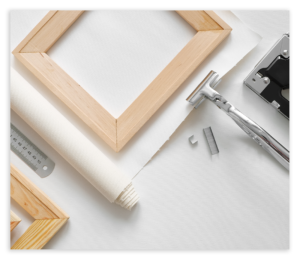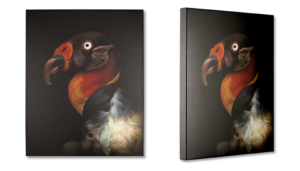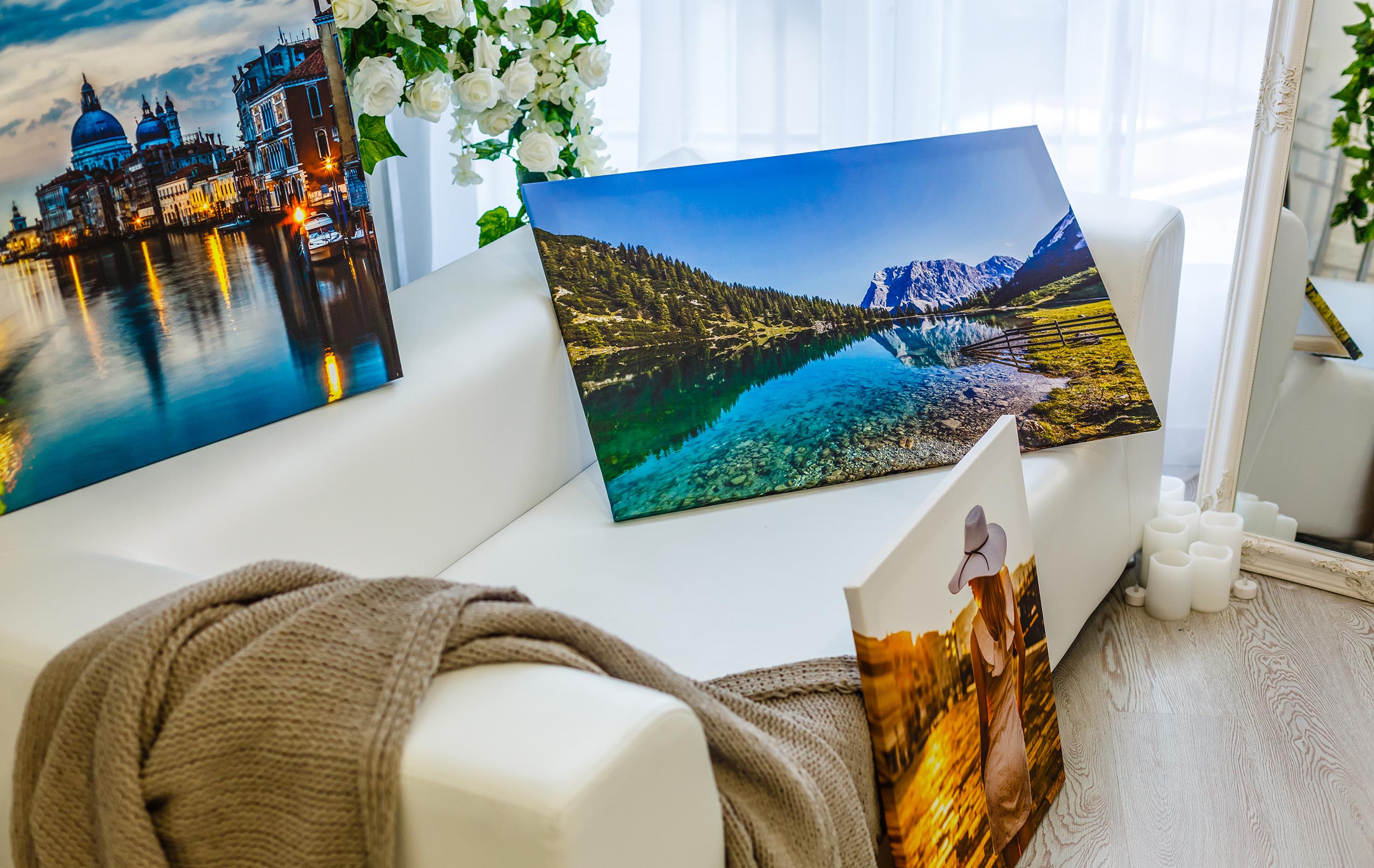
Updated: 04/22/2024
by Laura Gardiner
Studio Manager, Tribeca Printworks
A high-quality canvas giclee print is an image printed directly onto specially treated canvas material using an inkjet printer. Once the image is complete, printmakers stretch the canvas around a wooden stretcher bar.
Canvas prints can be presented by themselves or within an additional frame — typically a “floater frame” — that alleviates the need for any glass or acrylic covering the surface of the print. By eliminating the requirement of any surface glazing, the result is a tactile piece that has a natural dimensionality to it. Canvas prints have a modern, frameless feel to them.
What Is Canvas Made Out of?
A high-end canvas is a woven fabric typically made from a durable polyester-cotton blend with a receptor coating. Most high-quality giclee canvases are 65% cotton and 35% polyester, as pure cotton shrinks during printing and pure polyester does not provide the archival, exhibition-quality finish most artists and photographers prefer for their prints. Most canvas prints in homes and art galleries are made from a high-quality cotton-polyester blend canvas.
Canvas Prints vs. Framed Prints: Which Is Right for Your Space?
It’s common to mix print types to create eye-catching gallery walls. Still, you may consider whether a canvas, metal, acrylic or art print is best for a particular piece of artwork or photograph. Below, we compare metal, acrylic, and art prints with canvas prints to spark your imagination.
Metal vs. Canvas
Metal prints are photographs printed on aluminum or metal panels. Most panels have no glass or sharp edges, meaning they are damage-resistant and offer an industrial, modern look. Like many print types, you can choose between a matte, glossy, semi-glossy, or metallic finish. This finish determines whether the print is reflective.
Metal prints offer a vibrant, sharper look than a softer print like canvas. If your home or apartment has an unfinished, industrial aesthetic, a metal print would fit right in.
Acrylic vs. Canvas
Unlike the process for canvas prints, printmakers print acrylic prints directly onto photo paper. They then press the print between acrylic sheets or plexiglass, which is how this type receives its name. Acrylic prints are moisture-resistant and durable, often lasting a lifetime if properly cared for. This extended life span makes them a versatile print type for those who like to rearrange their spaces or move homes often.
Acrylic prints are typically frameless and complement virtually any interior design aesthetic depending on the framed piece’s style, including contemporary, minimalist, and midcentury aesthetics.
Art Print vs. Canvas
Similar to how printmakers print art onto canvas prints, they can also print your artwork onto cardstock or photographic paper for professional-looking art prints. Perhaps the best aspects of art prints are their quality and versatility. Our fine art prints come in many cardstock paper options, including Epson fine art and Hahnemühle photographic papers.
Because art prints are printed onto paper, you can select the frame type and style that suits your space best.
Why Should You Print on Canvas?

There are a few easy answers to this question. Canvas prints are more economical than traditionally framed prints, they don’t require any additional frame, and they are lightweight and incredibly durable.
One of the first qualities that you’ll likely notice about a stretched canvas painting, though, is the luminosity and brilliance. Most canvases for digital printing on the market today have a bright white coating and natural texture, allowing for matched vibrancy, depth, and detail as fine art paper prints. However, there is a wide range of canvas quality and printing techniques used to produce canvas prints so we want to help you make sure you’re finding the highest-quality materials out there. You can often find online print-to-canvas services at incredibly low price points. However, the price is going t
o reflect on the quality of the materials used and the finished piece.
You’ll want to make sure the printer you choose uses a high-quality, archival canvas, usually with a 65/35 cotton-to-poly blend, and prints with archival pigment inks. Along with rivaling original artwork in detail, digital printing on canvas offers the additional benefit of being durable and long-lasting, delivering beauty in your home or commercial space for many years to come.
Read more about the canvas materials we use, the printing process at Tribeca Printworks and how ordering works.
If I Decide to Print on Canvas, What Are My Options?
Most printers offering canvas prints will have an array of canvas finishes to choose from, including matte, glossy, satin, or metallic. A canvas print on its own is still just a loose print off a roll, so once you have chosen a canvas type, you will need to determine the finishing or framing.
The most common finishing for canvas prints is to have them “stretched” around a wooden or metal frame of varying depths, creating a stretched canvas. This is commonly called a “gallery wrap” as it is a stand-alone piece, ready to hang without additional framing or finishing and it is the finish most closely associated with canvas prints.
However, stretched canvases can be further placed into floater frames for a very polished, elegant and modern look or placed into any custom frame to emulate a traditional canvas painting.
Types of Canvas Print Layouts
Once you’ve decided to print onto canvas, you’ll want to select the canvas print layout that complements your space best. Whether you have a large, bare wall or a smaller space, a single canvas stands out as a statement piece. However, a multi-panel canvas layout is excellent for mixing print styles and frames to create dimension on large walls.
Should I Hang Canvas Prints in My Home?
Canvas prints can provide a number of design and decor solutions within the home. If you’re creating a salon-style gallery wall, incorporating canvas prints into the mix adds dimension and texture and a balance of framed and frameless elements. For personal use, canvas printing has become very popular for family portraits and wedding photography.
If you want to fill a large space with a single work, canvas prints will allow your image to fill the space at the maximum size for a fraction of the cost of a framed piece. If the area you wish to fill gets a lot of natural sunlight, a matte canvas is completely non-reflective and seems the obvious choice with this advantage.
You can also play around with splitting your image(s) into a diptych or triptych to create a seamless multi-panel layout.
Should I Exhibit and Sell My Work on Canvas?

Many artists and photographers choose to display and sell their work as limited editions on fine art papers for its high-end feel and the freedom it gives collectors for future framing. That does not, however, mean that you shouldn’t consider canvas for fine-art exhibition and sale.
One great benefit to printing on canvas is that it is an artist’s medium and can be treated as such. Canvases made for digital inkjet printing can be further embellished with acrylic
and oil paints, water-based varnishes and adhesives and other external materials, such as gold leaf. This allows artists to create impactful one-of-a-kind mixed media artworks that have become increasingly popular in the fine art world.
Canvas is also a great option for straightforward reproductions of original canvas paintings.
I See Canvas Prints Everywhere — Why Is That?
Chances are you’ve been in a restaurant, retailer, or corporate office that utilized large stretched canvases for decor. This is in part because designers know that filling large spaces with large framed artwork and photography can be very cost-prohibitive if you’re working on a budget. Large-format canvases will almost always come in at a fraction of the cost. This is also because large-format canvas prints have a modern look which provides dynamic visual impact as they are dimensional and unencumbered by traditional framing.
Order Custom Giclee Canvas Prints Online With Tribeca Printworks
If you’re ready to create stunning canvas prints using exhibition-quality canvases with your artwork or photography, partner with Tribeca Printworks. We streamline the made-to-order custom printing and framing process to get your prints to you on time and within budget. Our Online Print Studio allows you to upload images straight from your computer and design your new canvas print in minutes.
To get started, upload your images and select your print size and style before choosing a framing option. Add your final piece to your shopping cart, select your shipping method, and have your ready-to-hang, studio-quality canvas prints delivered anywhere in the world. You can also pick up your print from our Soho studio showroom.
If you’re still unsure about whether canvas prints are the right direction for your work, please do not hesitate to visit us in our SOHO Studio or contact us. We are always happy to guide you through the ordering process and advise you on the best choices for your work. Whatever your design or artistic preferences, our high-quality canvases and bespoke framing solutions create show-stopping designer art prints.
Ready to get started? Order now!
How Should I Frame My Photos and Artwork?
What is the best way to frame my photos and artwork? Framing your art and photography can transform a space and transform your work. The process can seem daunting and the possibilities endless, but we’re here to help simplify and shed some light…READ MORE
by Ashley Garner 04/16/2020
How Big Can I Print My Photos and Artwork?
So you want to print an image off of your phone, your DSLR, or *gasp* the internet! Maybe you’re trying to reproduce your original artwork? Your first question will most likely be, how big can I print this file? When faced with this question, we often respond with “how large is large for you?…READ MORE

